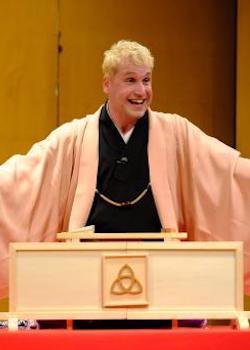Rakugo

Performed by Katsura Sunshine
Leicester Square Theatre, London
30 September to 15 October 2017
Review by Alex Rees
Rakugo (落語, meaning “fallen words”) is one of the Japanese performance traditions we are fortunate enough to experience today, as a result of an unbroken chain of teaching that stretches back at least to the 18th century. Equipped with only a fan (sensu) and a hand towel (tenugui) for props, and kneeling on a pillow for the entire performance, the lone rakugoka monologues comedic stories, tales, and anecdotes to their audience. These stories often require the performer to play several characters at once, which they differentiate through tone of voice, gesture, and changes in the angle of the head. The limitations placed on the performer and vast repertoires of stories that have to be memorised necessitate years of training in a traditional master-apprentice relationship. There are two recognised traditions of professional rakugo that train in this way: the “Edo” school of Tokyo, and the “Kamigata” school of Osaka.
Mr Katsura Sunshine is the first non-Japanese practitioner of the latter, only the second non-Japanese to be trained in either school, and the only living, professional, non-Japanese rakugoka. Following his early successes in theatre in his native Canada, he moved to Japan and completed a full Kamigata apprenticeship under master and TV presenter Katsura Bunkyo VI, who awarded Katsura Sunshine his stage name as per rakugo tradition. Mr Sunshine has been performing rakugo worldwide ever since, in English and in Japanese, and across 4 continents.
For those unfamiliar with rakugo, “traditional minimalist one-man storytelling from Japan” may sound like a daunting choice of entertainment. This becomes even more confusing if you try to apply whatever image this conjures to Katsura Sunshine; a broad-faced and beaming westerner with spiky, buttercup blonde hair, dressed in a traditional kimono that he wears so comfortably it looks like he was born in it, and armed with a name that seems almost deliberately esoteric. However, everything clicks into place when you see him perform. Sunshine is not just an excellent storyteller, he’s also adroitly aware of how he straddles the cultural divide. By using this to his advantage he makes a unique performance that can be enjoyed by connoisseurs and newcomers alike.
The meat of his performance lies in his renditions of classic rakugo tales; witty stories that build up your expectations with elaborate set-up before paying off with a laugh-out-loud punchline (several punchlines, if you’re lucky). On the night I attended we were treated to three of the more “traditional” rakugo stories. The first was Jugemu, a shaggy-dog story about a boy with a very long name; a name which Sunshine ably rattled off several times to increasingly impressed applause. Later came Momotaro, a Princess Bride style telling of a Japanese father recounting the folktale Momotaro to his Japanese-Scottish-American son, which Sunshine neatly wove into a parable of the differences and similarities between Japanese and Western culture.
Lastly we had and another rakugo classic, Chiritotechin, where two conniving friends set up an ungrateful acquaintance with a nasty “delicacy”. These parts of the show are where the methods and technique of rakugo are most evident, where the work that Sunshine has put into his storytelling art clearly and repeatedly pays off. Sunshine makes full use of the mime, masterful pacing, and careful articulation that rakugo offers, pairing them with his natural flair for telling a good story. Often it feels like this combination is so seamless that one loses sight of the individual techniques and become fully immersed in his flow.
To achieve this Sunshine compliments the main stories with a wealth of freeform anecdotes, about rakugo itself of course, but also Japan and Japanese culture more generally, and often concerning his own (mis)adventures. On the night I attended, they included accounts of keigo honourific language, sake drinking etiquette, tales of Sunshine’s own apprenticeship, and how he dealt with an audience who just wouldn’t stop filming him. These are interspersed among the actual rakugo stories and take up a good half of the runtime, keeping the pace of the show varied and keeping the audience up to speed. These sections don’t obviously involve the “rakugo techniques” to the same extent, but they are welcome additions to the night and Sunshine delivers them with a great deal of sparkly wit.
This is aided by Sunshine’s extremely genial performance style. He is unafraid to discuss his methods, and yet is also very modest; he is boisterously enthusiastic, but never boastful or aggressive, like many stand-up comedians. He seems to consider his performance something he enjoys sharing with his audience, and is an extremely attentive host. Indeed, he goes to striking lengths to keep the show accessible; very little knowledge of Japan or rakugo is assumed, and where it is necessary Sunshine goes to great length to prime the audience first. On occasion he even involves the audience by teaching a little Japanese. If this sounds dangerously like “edutainment”, it certainly doesn’t feel like it, and Sunshine makes learning a pleasure through constant encouragement.
All this comes together to make a show that is at once recognisably rakugo, and yet also uniquely Katsura Sunshine’s, a one-of-a-kind performance which will leave you tickled and feeling like you’ve learnt something new. If there’s any way to get into rakugo, it’s through him.

